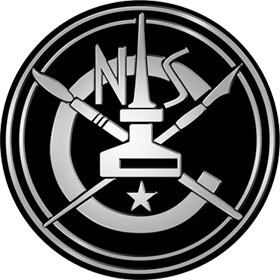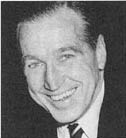
The National Cartoonists Society (NCS) is an organization of professional cartoonists in the United States. It presents the National Cartoonists Society Awards. The Society was born in 1946 when groups of cartoonists got together to entertain the troops. They enjoyed each other's company and decided to meet on a regular basis.

Sergio Aragonés Domenech is a Spanish/Mexican cartoonist and writer best known for his contributions to Mad magazine and creating the comic book Groo the Wanderer.

Don Martin was an American cartoonist whose best-known work was published in Mad from 1956 to 1988. His popularity and prominence were such that the magazine promoted Martin as "Mad's Maddest Artist."

William Aloysius "Bil" Keane was an American cartoonist most notable for his work on the newspaper comic The Family Circus. It began in 1960 and continues in syndication, drawn by his son Jeff Keane.
George Booth was an American cartoonist who worked for The New Yorker magazine. His cartoons usually featured an older everyman, everywoman, or everycouple beset by modern complexity, perplexing each other, or interacting with cats and dogs.

Virgil Franklin Partch, who generally signed his work Vip, was an American gag cartoonist. His work appeared in magazines of the 1940s and 1950s, and he created the newspaper comic strips Big George and The Captain's Gig. He published 19 books of illustrations and drew art for children's books.

Melvin Lazarus was an American cartoonist, best known as the creator of two comic strips, Miss Peach (1957–2002) and Momma (1970–2016). Additionally, he wrote two novels. For his comic strip Pauline McPeril, he used the pseudonym Fulton, which is also the name of a character in his first novel, The Boss Is Crazy, Too.
A gag cartoon is most often a single-panel cartoon, usually including a caption beneath the drawing. A pantomime cartoon carries no caption. In some cases, dialogue may appear in speech balloons, following the common convention of comic strips.

Don "Duck" Edwing was an American gag cartoonist whose work has appeared for years in Mad. His signature "Duck Edwing" was usually accompanied by a small picture of a duck, and duck calls were heard on his answering machine. Mad editor John Ficarra said, "He's exactly how people picture a Mad magazine writer." In 2007, Edwing told an interviewer, "I always believed that when you choose your field, you should specialize. You never deviate. I chose 'sick puppy'."

Laugh Parade was a group of weekly gag cartoons written by Bunny Hoest and drawn by John Reiner. It ran in Parade, a Sunday newspaper magazine supplement.
Charles David Saxon was an American cartoonist known for his work for The New Yorker.

William Pierce Hoest was an American cartoonist best known as the creator of the gag panel series, The Lockhorns, distributed by King Features Syndicate to 500 newspapers in 23 countries, and Laugh Parade for Parade. He also created other syndicated strips and panels for King Features.

Chauncey Addison Day, better known as Chon Day, was an American cartoonist whose cartoons appeared in The New Yorker and other magazines.
John Joseph Gallagher (1926–2005) was an American cartoonist and illustrator. He contributed to most major magazines in the 1950s and 1960s, signing his work “Gallagher.” He won the National Cartoonist Society Gag Cartoon Award in 1957 and 1971.

Jack Markow (1905-1983) was an American cartoonist who also wrote instructional books about cartooning, comic strips and comic art. For three years, he was the cartoon editor of Argosy.
Glenn McCoy is a conservative American cartoonist, whose work includes the comic strip The Duplex and the daily panel he does with his brother Gary entitled The Flying McCoys. McCoy previously produced editorial cartoons until May 2018, when he refocused his career on animations after being discharged from his job of 22 years at the Belleville News-Democrat. All three cartoon features are syndicated by Andrews McMeel Syndication.
Rick Stromoski is an American cartoonist whose work includes the syndicated comic strips Mullets and Soup to Nutz.

Mort Gerberg is a multi-genre American cartoonist and author whose work has appeared in magazines, newspapers, books, online, home video, film and television. He is best known for his magazine cartoons, which have appeared in numerous and diverse titles such as The New Yorker, Playboy, Harvard Business Review, The Huffington Post and Paul Krassner's The Realist, and for his 1983 book, "Cartooning: The Art and The Business". He created a weekly news cartoon, Out of Line, for Publishers Weekly from 1988 to 1994 and has drawn an editorial-page cartoon for The Columbia Paper, the weekly newspaper in Columbia County, New York, since 2003.

Bob Dunn was an American cartoonist, entertainer and gagwriter who drew several comic strips. In addition to his own strips, Dunn was known for his work on Jimmy Hatlo's Little Iodine and They'll Do It Every Time, and is said to have invented the modern knock-knock joke in 1936.
Laff-a-Day is a daily gag cartoon panel distributed to newspapers by King Features Syndicate from 1936 to 1998. The cartoonists included Frank Beaven, Henry Boltinoff, Dave Breger, Bo Brown, Orlando Busino, George Gately, Martin Giuffre, Al Kaufman, Reamer Keller, Harry Mace, Jack Markow, Don Orehek, Charles Skiles, Eli Stein, Jack Tippit and Bill Yates.













